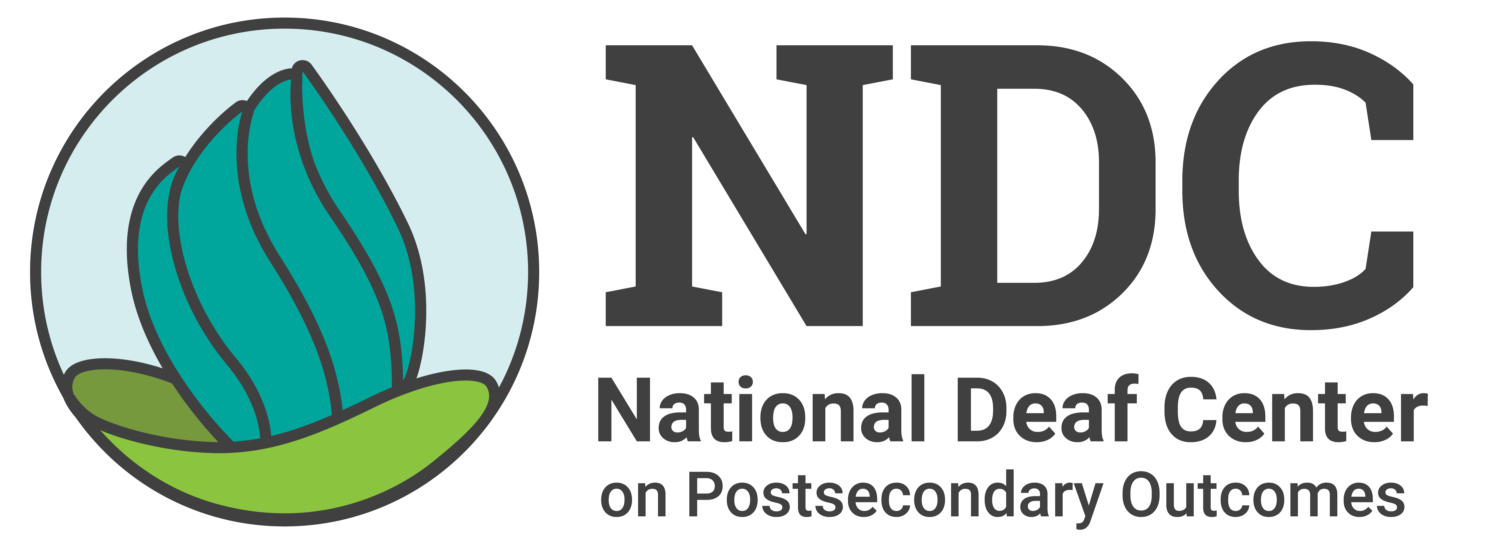Home » Resources » Access & Accommodations » Creating Welcoming Campuses
Creating Welcoming Campuses
Campus experiences provide students with access to people and opportunities that promote personal growth, networking opportunities, and a sense of belonging to a community. Accessibility is at the heart of ensuring equal opportunities for deaf college students, allowing them to access information in academic and social contexts while actively participating in the college community. Strengthening outcomes for deaf students is more than just accommodations, rather it is granting them access to the opportunities and resources available on campus. To dive deeper into emerging challenges and new data about deaf college students, check out this article.
Creating a welcoming campus is a shared responsibility—one that requires commitment from administrators, faculty, staff, and students alike. Access isn’t just the job of disability services; it should be woven into every aspect of campus life, from classrooms and housing to student activities and captioning digital content. Faculty can ensure course materials are accessible, event organizers can provide captions and interpreters, and administrators can invest in policies that remove barriers. When everyone plays a role in fostering access, deaf students can fully engage, contribute, and thrive. Accessibility isn’t an accommodation—it’s a collective effort toward creating safe and welcoming spaces for deaf students.
Ensuring that programs, services, and facilities are accessible for deaf people is not only a legal responsibility but fundamental to fostering an inviting and welcoming environment. College and university campuses can ensure quality access to their campus through proactive planning, clear protocols, interdepartmental communication, and capacity building.
Proactive Planning
Proactive planning means incorporating accessibility considerations from the beginning of program or event planning, preventing missed opportunities for accessibility. This welcoming approach, considering a wide range of participants during the planning stages, leads to accessibility for all students.
Clear Protocols
Establishing clear protocols ensures that standard procedures are in place to acquire and generate resources for event accessibility. Designating a single point of contact to oversee the procurement process can minimize errors, promote consistency, and enhance efficiency in confirming accessibility arrangements.
Interdepartmental Communication
Clear procedures, understanding of roles, and cross-department communication is key to coordinating access effectively. Even when funding or logistics are spread across departments, accessibility is an institutional responsibility. To prevent confusion, gaps in service, or delays with access, departments need to know who to contact, their specific responsibilities, and the steps to follow.
Strategies for Building a Welcoming Campus
A great first step is to make sure all departments know how to support deaf students. The Improving Campus Access Online Module is a helpful tool for training staff, faculty, disability services professionals—and even administrators—on how to create a better campus for all students. By learning about available accommodations and resources, staff can make campus spaces more welcoming and accessible.
It’s also important that student groups, faculty, and staff work together and communicate interdepartmentally to avoid putting all of the burden onto deaf students. Fostering connections among students is important for making them feel like they belong, but it should not solely be the students’ responsibility to coordinate those efforts. Everyone on campus can work toward making it a place where every student feels supported.
At the end of the day, this work requires teamwork. Disability Services and campus leaders play a big part in making sure deaf students get the support they need. If you’re looking for even more information on this, the Campus Accessibility Guide offers helpful steps for making your campus more accessible for deaf students!
Creating an Accessible Campus: A Shared Effort
Making campus accessible for deaf students isn’t just one office’s job—it’s a shared commitment that extends across the whole institution. From faculty and IT to HR and event planners, everyone plays a part in making sure access is planned, delivered, and sustained.
True access ensures deaf students can fully participate in every aspect of campus life– classrooms, activities, and beyond. Achieving this requires more than minimal compliance; it means building student-centered policies guided by the lived experiences of deaf people.
Access, Belonging, and Affirmation: DPAIS Report (2022-2023)
During the 2022–2023 academic year, NDC surveyed deaf students in higher education institutions across the nation. This report provides a comprehensive overview of survey results and offers suggestions for improving access and participation for deaf students on campus.
A Need for Accessible Tutoring Services for Deaf Students
Tutoring is a valuable resource for deaf students as they navigate their educational journey. It provides additional support for building study skills, understanding course materials, and strengthening reading and writing. In mainstream settings, deaf students may have fewer opportunities for casual learning through peer conversations, and tutoring services can create a space for deeper engagement with academic content and discussions. As students transition from high school to college, tutoring can also offer individualized support, meaningful connections, and strategies that promote success in their educational journey.
Campus Experiences
Making sure deaf students have an equal and supportive experience on campus takes teamwork. It includes everything from physical spaces and communication to student support and learning opportunities outside the classroom. This means building good relationships, listening to feedback, and making sure everyone has access to the support that they need to succeed. It’s important to provide ways for deaf students to share their thoughts on the services they are using so that improvements can be made. When campuses pay attention to student feedback, they can keep making changes to improve access and support for everyone.
Accessible buildings and spaces are crucial for deaf students. This includes not only classrooms and dorms, but also public areas and emergency systems. Campuses should have visual fire alarms and emergency alerting systems that help students safely leave a building during emergencies. It’s also important that public spaces, like dining halls and libraries, utilize visual methods of access to ensure that everyone can use their services.
Communication is key to making sure deaf students can fully join their campus community and socialize with peers. Captioned media, sign language interpreters, speech-to-text services, and other accommodations ensure that students can understand what’s happening in class, in meetings, or at events.
Student activities and organizations should be open to everyone. Events on campus can be more accessible by providing interpreters or captions. It’s also helpful to guide deaf students in utilizing Disability Services Offices and other campus resources. Our Tips for Deaf Students playlist can give helpful advice on how to use these services, how to work with interpreters, and more.
Internships, practicums, and clinicals are great ways for deaf students to gain work experience and skills that will translate beyond the classroom. For these opportunities to be fair, they must be accessible to all students. This means providing any needed accommodations, like interpreters or captioning, so that deaf students can fully participate.
Studying abroad is another valuable experience, as it gives students a chance to learn about new cultures and prepare for future careers. Campuses should make sure that study abroad programs are accessible by offering support and ensuring students have the resources they need when traveling to a new country. For more on this, please check out our Study Abroad Planning Guide.
Studies have shown that deaf people experience mental health issues at nearly twice the rate of hearing people, yet they often lack equal access to mental health services. The Disability and Health Data System (DHDS) has found that 35.8% of deaf people ages 18 and older have experienced “mentally unhealthy days in the past 30 days.” 21.6% of hearing students report a mental, emotional, or psychiatric condition—but only 7.6% of deaf students do (Bloom & Palmer, 2023). The difference may be the result of inaccessible mental health evaluation and support services for deaf people, among other factors, which highlights the importance of ensuring that all campus facilities and services are accessible to deaf people.
Campus Facilities: Housing & More
A guide to improving campus facilities to better support deaf students, including considerations for visual alert systems, accessible signage, classroom design, and creating environments that support communication and connection.
Transforming Systems to Improve Experiences for Deaf People
Transforming Systems to Improve Experiences for Deaf People is a free, online self-paced module introducing systems theory as a framework for examining structural barriers that impact access to education and training opportunities for deaf people. Participants will explore system components, examine structural barriers, and consider opportunities to start creating real system change that can be sustained over time. This module offers a new perspective that asks participants to shift focus beyond solving day-to-day barriers to addressing more deeply embedded system barriers.
Take Action: Making Changes for the Future
Making sure deaf students have the support they need isn’t something that happens once and is done—it’s about making long-term changes to the whole campus. A systemic approach means looking at every part of the campus and finding ways to make it more accessible for everyone. Campuses need to plan for a brighter future and follow-through with those plans to make sure their improvements are lasting. This means prioritizing accessibility as part of the institution’s goals and values. Success comes from everyone on campus working together to make things better over time.
We encourage teachers, staff, and students to take action by joining training programs, looking at how accessible the campus is, and exploring the Deaf Awareness Micro Certificate. Ongoing learning and growth are important for making sure deaf students always get the support they need. We encourage everyone on campus—DSS professionals, faculty, staff, and students—to keep learning and working together to make their campus a better place. Start by exploring the resources available on our website and begin making changes today!





